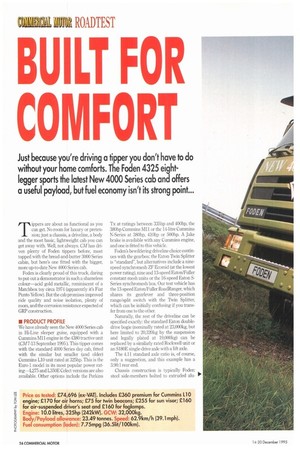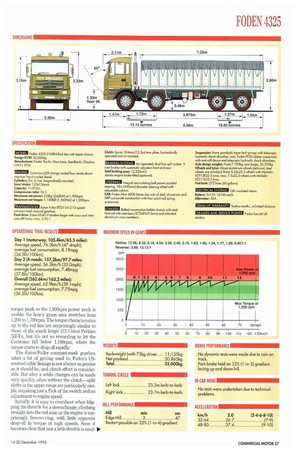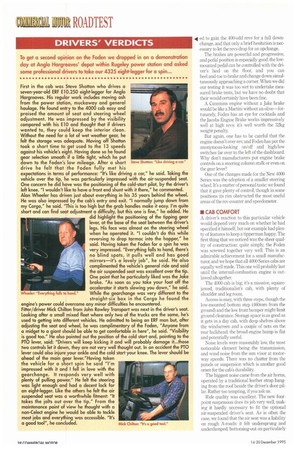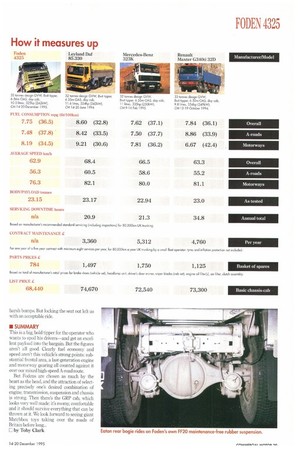UILT FOR COMFORT
Page 26

Page 28

Page 29

Page 30

Page 31

If you've noticed an error in this article please click here to report it so we can fix it.
Just because you're driving a tipper you don't have to do without your home comforts. The Foden 4325 eightlegger sports the latest New 4000 Series cab and offers a useful payload, but fuel economy isn't its strong point...
Tippers are about as functional as you can get. No room for luxury or pretension; just a chassis, a driveline, a body and the most basic, lightweight cab you can get away with. Well, not always. CM has driven plenty of Foden tippers before, most topped with the bread-and-butter 3000 Series cabin, but here's one fitted with the bigger, more up-to-date New 4000 Series cab.
Baden is clearly proud of this truck, daring to put out a demonstrator in such a shameless colour—acid gold metallic, reminiscent of a Matchbox toy circa 1974 (apparently it's Fiat Punto Yellow). But the cab promises improved ride quality and noise isolation, plenty of room, and the corrosion resistance expected of GRP construction.
• PRODUCT PROFILE
We have already seen the New 4000 Series cab in Hi-Line sleeper guise, equipped with a Cummins M11 engine in the 4380 tractive unit (2M7-13 September 1995). This tipper comes with the standard 4000 Series day cab, fitted with the similar but smaller (and older) Cummins L10 unit rated at 325hp. This is the Euro-1 model in its most popular power rating—L275 and L350E Celect versions are also available. Other options include the Perkins Tx at ratings between 335hp and 400hp, the 380hp Cummins M11 or the 14-litre Cummins N-Series at 380hp, 410hp or 500hp. A Jake brake is available with any Cummins engine, and one is fitted to this vehicle.
Foden's bewildering driveline choice continues with the gearbox: the Eaton Twin Splitter is "standard", but alternatives include a ninespeed synchromesh ZF Ecomid (at the lowest power rating), nine and 13-speed Eaton/Fuller constant-mesh units or the 16-speed Eaton SSeries synchromesh box. Our test vehicle has the 13-speed Eaton/Fuller RoadRanger, which shares its gearlever and three-position range/split switch with the Twin Splitter, which can be initially confusing if you transfer from one to the other.
Naturally, the rest of the driveline can be specified exactly: the standard Eaton doubledrive bogie (nominally rated at 23,000kg, but here limited to 20,320kg by the suspension and legally plated at 19,000kg) can be replaced by a similarly rated Rockwell unit or an S180E single-drive axle with a lift axle.
The 4.11 standard axle ratio is, of course, only a suggestion, and this example has a 3.90:1 rear end.
Chassis construction is typically Foden: steel side-members bolted to extruded alu minium cross-members, and the brochure promises that frame rails can be specified to give any legal wheelbase. The standard figure is 5.875m (front axle to mid-point of rear bogie) with an outer axle spread of 6.56m. Paccar provides the massive alloy mountings for the rear FF20 rubber suspension.
Front suspension is a conventional leaf system, while the cab has four-point coil springing with an anti-roll ban The cab itself uses GRP panels (which, Foden stresses, are fire-retardant) and aluminium doors. Unlike the tractive unit, the tipper has a hefty all-steel front bumper.
The cab can, of course, be painted in any colour you want, with the chassis in the same or a contrasting tone.
• PRODUCTIVITY
Paden does seem to have perfected the trick of making a lightweight tipper—even with the full-width 4000 Series cab this truck claims a body/payload allowance of 23.49 tonnes; right at the top of its class. Admittedly this is with alloy wheels which save 232kg, and the Cummins engine option is 91kg lighter than the Perkins, but this figure apparently beats even the Cummins-equipped 3000 Series.
In fact, fitted with a Wilcox Wilcolite body (favourite with the weight-conscious manufacturer) the usable payload came to around 20.84 tonnes, which is good, but not world-beating. As the average Wilcolite body usually weighs just under two tonnes, this suggests that the quoted chassis weight might be a little optimistic.
Where the Foden's productivity falls down is in fuel economy: this example returned an average of just 7.75mpg overall round our Midlands tipper route—significantly worse than other Cummins-powered machines, including an earlier Foden 3325. Whether this was due to mismatched gearing, low mileage (our test vehicle had covered just 5,000km), or the frontal area of the larger cab is uncertain.
The average speed was unimpressive, too, though the Edge Hill climb compared well with similarly powered vehicles
• ON THE ROAD
The LIO isn't the most advanced engine in the world, and it loses out in comparison to the awesome torque of the slightly bigger M11. But the spread of power is still impressive and, while it's a little irritating that Foden's rev-counter has just a green and a red band, every part of the range from the 1,200rprn torque peak to the 1,900rpm power peak is usable; the heavy green area stretches from 1,200 to 1,700rpm. The torque characteristics up to the red line are surprisingly similar to those of the much larger (12.7-litre) Perkins 335Tx, but it's not so rewarding to let the Cummins fall below 1,100rpm, where the torque starts to drop off rapidly.
The Eaton/Fuller constant-mesh gearbox takes a bit of getting used to: Foden's USsourced cable linkage is not always as precise as it should be, and clutch effort is considerable. Rut after a while changes can be made very quickly, often without the clutch—split shifts in the upper range are particularly simple, requiring just a flick of the switch and an adjustment to engine speed.
Initially it is easy to overshoot when blipping the throttle for a downchange, climbing straight into the red zone as the engine is surprisingly free-revving, with little apparent drop-off in torque at high speeds. Soon it becomes clear that just a little throttle is needPio
.14 ed to gain the 400-odd revs for a full downchange, and that only a brief hesitation is necessary to let the revs drop for an upchange.
The brakes are powerful and progressive, and pedal position is especially good: the lowmounted pedal can be controlled with the driver's heel on the floor, and you can heel-and-toe to brake and change down simultaneously approaching a corner. When we did our testing it was too wet to undertake measured brake tests, but we have no doubt that their would certainly have been fine.
A Cummins engine without a Jake brake would be like a Martini without an olive—for tunately, Foden has an eye for cocktails and the Jacobs Engine Brake works impressively well at high revs: it's well worth the 32kg weight penalty.
But again, one has to be careful that the engine doesn't over-rev, and Foden has put the anonymous-looking on/off and high/low switches far over to the left of the dashboard. Why don't manufacturers put engine brake controls on a steering column stalk or even on the gear lever?
One of the changes made for the New 4000 Series was the adoption of a smaller steering wheel. It's a matter of personal taste: we found that it gave plenty of control, though in some 7ositions its rim obstructed the most useful areas of the rev-counter and speedometer.
• CAB COMFORT A driver's reaction to this particular vehicle would depend very much on whether he had specified it himself, but our example had plenh., of features to keep a tipperman happy. The first thing that we noticed was the sheer quality of construction: quite simply, the Foden was screwed together very well. This is an admirable achievement for a small manufacturer, and we hope that all 4000 Series cabs are equally well made. This one will probably last until the internal-combustion engine is outlawed altogether.
The 4000 cab is big; it's a massive, squarejawed, traditionalist's cab, with plenty of shoulder and leg room.
Access is easy, with three steps, though the low-mounted bottom step (460min from the ground) and the low front bumper might limit ground clearance. Storage space is as good as it gets in a day cab, with deep shelves above the windscreen and a couple of nets on the rear bulkhead: the broad engine hump is flat and potentially useful.
Noise levels were reasonably low, the most noticeable element being the transmission, and wind noise from the sun visor at motorway speeds. There was no chatter from the panels or suspension which is another good omen for the cab's durability The biggest noise came from the air horns, operated by a traditional leather strap hanging from the roof beside the driver's door pillar. Rather too tempting, if you ask us.
Ride quality was excellent. The new fourpoint suspension does its job very well, making it hardly necessary to fit the optional air-suspended driver's seat. As is often the case, we found that the air seat was a liability on rough A-roads: it felt undersprung and underdamped, bottoming-out on particularly harsh bumps. But locking the seat out left us with an acceptable ride.
• SUMMARY
This is a big, bold tipper for the operator who wants to spoil his drivers-and get an excellent payload into the bargain. But the figures aren't all good. Clearly fuel economy and speed aren't this vehicle's strong points: substantial frontal area, a last-generation engine and motorway gearing all counted against it over our mixed high-speed A-road route.
But Fodens are chosen as much by the heart as the head, and the attraction of selecting precisely one's desired combination of engine, transmission, suspension and chassis is strong. Then there's the GRP cab, which looks very well made: it's roomy, comfortable and it should survive everything that can be thrown at it. We look forward to seeing giant Matchbox toys taking over the roads of Britain before long...
E by Toby Clark












































































































